This site is made possible by its sponsors.
Please visit them!
hollow building - A ceramic technique for sculpture in which the form is built up from slabs and tubes of damp clay in such a way that it is hollow throughout. Ceramic sculptures are made hollow, chiefly to ensure that no part is much thicker than any other; such differences in thickness would create tensions in the clay during firing, as the clay shrinks in cooling.
hollow carving - Wooden sculptures are often hollowed or partly hollowed in order to avoid strain resulting from the different rates of shrinkage in heartwood and sapwood. stone is also hollowed out, but to enable it to be supported (especially in the case of a bust, for example) or to be lifted and transported more easily. Ceramic sculptures are made hollow, chiefly to ensure that no part is much thicker than any other; such differences in thickness would create tensions in the clay during firing, as the clay shrinks in cooling.
hollow casting - Casting in a mold by lining the walls of the mold with layers of sculpture material rather than filling up the mold. The technique varies with the medium being used. Cast metal sculptures are made hollow chiefly to ensure that no part is much thicker than any other; such differences in thickness would create tensions in the metal as it shrinks in cooling.
holography - A medium for producing a three-dimensional image of an object by recording on a photographic film the pattern of interference formed by a split laser beam and then illuminating the pattern either with a laser or with ordinary light. The resulting object is a hologram, also known as a holograph.
(pr. ho-LAHG-rə-fee)
Other resources about holography:
homage - Special acknowledgment or respect shown or expressed publicly to persons whose influence an artist wishes to honor.
(pr. HAHM-'əj)
An example of a work done in homage to another artist:
Larry Rivers (American, 1923-2002), Dutch Masters I, 1963, oil on canvas, Cheekwood Art Museum, Nashville.
A quotation apropos homage:
homogeneity, homogeneous - Homogeneity is the quality of uniformity of structure throughout or composed of parts that are all of the same nature or kind.
Also see balance, coherence, complexity, monotony, pattern, principles of design, and unity.
hooptedoodle - A literary word that, technically, has no place being in this dictionary. Hooptedoodle is stuff that gets in the way of a story's making progress, it is wordy, unnecessary, space-taking, and, typically, should be edited out. Related to balderdash, folderol, flummery, foolishness, and fill; nonsense, prattle, blather, bombast, and baloney.
Quotes about hooptedoodle:
Also see bad art, banausic, bric-a-brac, brummagem, camp, decoration, decorative, decorative arts, gewgaw, kitsch, ornament, taste, and tchotchke.
horizon line - A level line where water or land seems to end and the sky begins. Vanishing points are usually located on this line. The image behind this text features a horizon line separating sky from sea — which, as you look lower, morphs into sky again, etc. (Notice too, the way rows of waves are depicted as receeding toward vanishing points.)
Quote:
Other resources concerned with horizon line:
horizontal - Straight and flat across, parallel to the horizon. The opposite is vertical. All other directions are diagonal.
Examples of notably horizontal works:
Maurits Cornelis Escher (Dutch , 1898-1972),
Metamorphosis II. See metamorphosis,
Op Art, optical
illusion, and tessellation.![]()

Kenneth Snelson (American, 1927-), Brooklyn
Bridge, 1980, gelatin silver print, 15 1/2 x 91 5/15 inches,
Cleveland Museum of Art. See panorama
and photography.
|
In graphics software, to make the following change is to "flip horizontally" |
Also see align and alignment, frieze, horizon line, invert, and perpendicular.
 horn - One of a pair of pointy projections,
either straight, curved
or helical, which have grown
from the head of an animal. The animals that have horns include
cows, sheep, goats, antelope, and their relatives. The rhinoceros
is an exception because its single horn grows from its nasal bone.
Deer grow antlers instead of horns. Antlers are made of bone,
and go through annual cycles of growing out and shedding. "Horn"
can also refer to a substance which is the outermost part of a
horn — tough keratin, a type of protein. It usually develops
as a conical sheath over bone.
Keratin also covers the hooves, claws, and nails of various animals,
as well as armadillo and tortoise
shells, the scales of the pangolin, porcupine quills,
and birds' feathers. A rhinoceros
horn is the only horn that is a solid growth of keratin. It also
consists of some fused hair.
horn - One of a pair of pointy projections,
either straight, curved
or helical, which have grown
from the head of an animal. The animals that have horns include
cows, sheep, goats, antelope, and their relatives. The rhinoceros
is an exception because its single horn grows from its nasal bone.
Deer grow antlers instead of horns. Antlers are made of bone,
and go through annual cycles of growing out and shedding. "Horn"
can also refer to a substance which is the outermost part of a
horn — tough keratin, a type of protein. It usually develops
as a conical sheath over bone.
Keratin also covers the hooves, claws, and nails of various animals,
as well as armadillo and tortoise
shells, the scales of the pangolin, porcupine quills,
and birds' feathers. A rhinoceros
horn is the only horn that is a solid growth of keratin. It also
consists of some fused hair.
Horn has been used as a medium in the production of combs, buttons, the handles of canes and knives, drinking-cups, spoons, snuff-boxes, and other objects.
Trade in the horns of certain
animals is unethical (sometimes illegal) often because its species
is in danger of extinction. Antlers are more ethical to use in
producing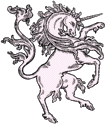
![]() art, because antlers are naturally shed by deer (and related animals)
annually, falling to the ground where they can be collected. Various
plastics simulate
horn quite well. Plastics might be considered a more moral alternative
to horn or as an overly artificial
substitute. Horn is comparable in some ways to ivory, teeth, bone, and shell; the use of any
of which is also capable of generating ethical dilemmas. Wood,
glass,
art, because antlers are naturally shed by deer (and related animals)
annually, falling to the ground where they can be collected. Various
plastics simulate
horn quite well. Plastics might be considered a more moral alternative
to horn or as an overly artificial
substitute. Horn is comparable in some ways to ivory, teeth, bone, and shell; the use of any
of which is also capable of generating ethical dilemmas. Wood,
glass,  and
stone are among the other
alternatives to horn.
and
stone are among the other
alternatives to horn.
The unicorn is a mythological horse that projects one horn from its forehead.
Devils, cuckholds, and various
fantastic creatures are traditionally depicted
as having horns.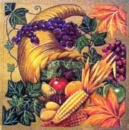
![]()
Hollow horns have been used as
vessels. "Powderhorns" hold gunpowder, and were long
made of horn. A cornucopia or "horn of plenty" is a
goat's horn overflowing with fruit, flowers and grain. The legendary
Greek nymph Amalthea's magical horn rewarded its possessor's every
wish. Now the cornucopia is a symbol
of abundance.
In music,
either an early instrument made of an animal's horn (e.g. a shofar), or a wind instrument made of
brass and consisting of a
long

![]() tube with a flared end that produces
a sound when the player's lips vibrate together in the mouthpiece
— barritone horns, bugles, saxophones, French horns, tubas, Flugelhorns,
trombones, cornettes, and trumpets.
tube with a flared end that produces
a sound when the player's lips vibrate together in the mouthpiece
— barritone horns, bugles, saxophones, French horns, tubas, Flugelhorns,
trombones, cornettes, and trumpets.
Any shape or form which resembles a horn, such as one of the curved ends of a crescent, a mountain peak, an erect penis, the beak-shaped part of an anvil, etc.
Examples of works employing horns as either material or content:

Parthia,
Rhyton, 2nd-1st centuries BCE,
ivory, Hermitage Museum,
St. Petersburg, Russia. See rhyton.

Germany, Crossbow of Ulrich V, Duke of Württemberg,
1460, wood, iron, ivory,
horn, whalebone, tendon, length
28 1/4 inches (71.7 cm), Metropolitan Museum of Art, NY. See
arms and armor.

André-Charles
Boulle, Wardrobe (alternatively known as an Armoire), Paris, around 1700, made of oak and pine, with
ebony, tortoiseshell, inlaid (marquetry)
with brass and tin
veneering, pewter,
horn, and gilded bronze
(ormolu), 102 x 58 x 25 inches
(260 x 148 x 64 cm), Louvre. See furniture and wood.
Jacob Gay (American, recorded 1758-1787, New York), Powderhorn, 1759, cowhorn, length 15 1/2 inches (39.4 cm), Metropolitan Museum of Art, NY. See American Colonial art.

Jacob Kuntz (American, 1780-1876, Philadelphia),
"Kentucky" Flintlock Rifle,
c. 1810-15, steel,
maple, brass, silver, bone, horn,
length 59 1/4 inches (150.5
cm), Metropolitan Museum of Art, NY.

Gustave
Moreau (French, 1826-1898), The Unicorn, 1885, oil
on canvas, Musée Gustave
Moreau, Paris. See Symbolism.
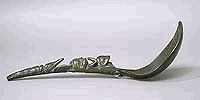
![]()
![]()
Tlingit or Tsimshian, native peoples of British
Columbia, Canada, Ceremonial Spoon, late 19th century,
mountain goat horn, copper rivets,
length 27.1 cm, collected
by Lt. George Thornton Emmons near Dixon's Entrance, BC, Peabody
Museum, Harvard U, Cambridge, MA. Such spoons were used only
for potlatch ceremonies. They were likely kept by the clan leaders
or nobility in baskets or bentwood
boxes. This is one of 40 such spoons in the Peabody Museum's
collection.

Côte
d'Ivoire (Ivory Coast), Senufo peoples, Mask, 19th-20th century, wood,
horn, fiber, cotton, feather, metal,
sacrificial material, height
of mask 14 1/8
inches (35.9 cm), Metropolitan Museum of Art, NY. See African art.

Nigeria, Janiform Cap Mask with Horns, 19th-20th
century, carved wood, pigment,
horns.

A
talisman of unidentified origin and meaning, probably
contemporary, apparently gold, translucent
red and blue gems, and bone
or horn fragments.
This image shows it emanating a mysterious luminosity.
This jewel is analogous
to purportedly powerful objects in Hollywood's pseudo-archaeological
adventure stories, like the mummy and Indiana Jones movies. See
talisman.
Also see animalia, auditory, cone, German art, heraldry, Kunstkabinett and Kunstkammer, nature, rhyton, satyr, scraper, spatula, taxidermy, and Wunderkabinett and Wunderkammer.
horologist and horologer - A person who practices or is skilled in horology. Horologists (alternatively called horologers) include those who design and craft timepieces, and perhaps connoisseurs of them as well. (pr. hah-RAH-le-jist and hah-RAH-lə-jer) Also see art careers.
 horology - Horology is the art
and science of making timepieces
— clocks, sundials, watches, etc. Horology is abbreviated horol.
horology - Horology is the art
and science of making timepieces
— clocks, sundials, watches, etc. Horology is abbreviated horol.
(pr. hah-RAH-lə-jee)
Examples of timepiece designs:

François de Hecq (French), Coach Watch with the Arms of Cardinal Richelieu, c. 1640, silver, gilt brass, Louvre.

Paris, France, Watch: Young Louis XIV on Horseback,
c. 1650, enamel, gold, diameter
2 5/16 inches (5.8 cm), Metropolitan Museum of Art, NY.

Attributed
to Pierre Phillipe Thomire and Sauvageot (French, 1751-1843),
Clock with Vestals, 1785, marble, gilt
bronze, Minneapolis Institute of
Arts.

Samuel Best (American, Cincinnati, 1776-1859),
Tall-Case Clock, 1810-15, mahogany and cherry with maple
veneer and inlay,
104 5/8 x 19 3/4 x 11 1/8 inches (265.7 x 50.2 x 28.3 cm), Cincinnati
Art Museum, OH. See wood.

Antoní Gaudí (Spanish, 1852-1926),
Wall clock from the Casa Milá, Barcelona,
1906-1910, gilded wood,
private collection. See architect,
architecture,
Art Nouveau,
and Spanish art.

Charles Rennie Mackintosh, designer (Scottish,
1868-1928), Domino Clock, c. 1917, wood,
ebony, ivory, erinoid
(brand of polyvinyl chloride
(PVC)), Glasgow Museums. See Arts
and Crafts Movement and Scottish
art.

David Ralston (Scottish, contemporary), Ball
Clock, c. 2003, billiard balls, brass,
and mixed media, 1.8 x 1.8
x .6 m, weight 35 kg, collection
of the artist.
Related links:
Also see horologist, interdisciplinary, jewelry, measurement, movement, ormolu, periodicity, science and art, sequence, and time.
horror vacui - The compulsion to make marks in every space. Horror vacui is indicated by a crowded design. In Latin, it is literally, "fear of empty space" or "fear of emptiness." Some consider horror vacui one of the principles of design. Those who exclude it from their list of principles apparently interpret it as posessing an undesirable, perhaps obsessive quality, in contrast to the desirable, controlled principle of limitation, or perhaps to that of emphasis or dominance.
(pr. horror vack'wee)
Example:

Richard Dadd (British, 1817-1886), The Fairy Feller's Master-Stroke, 1855-64,
oil on canvas,
54.0 x 39.4 cm, Tate Gallery, London. After murdering his father
in 1843, Dadd was diagnosed as insane and spent the rest of his
life in asylums. Cut off from the outside world, he produced
a series of paintings which combine a remarkable attention to
detail with an individual,
manic intensity. The horror vacui seen in Dadd's pictures may
be a result of his severe mental illness. See art
brut.
Quote:
Also see allover painting, balance, busy, Collyers' Mansion, composition, folk art, interesting, monotony, passage, and Zen.
hoso-e - In Japanese art tradition, a small narrow print.
Also see hashira-e, kakemono, and kakemono-e.
hot glue, hot glue gun, hot-melt glue gun
- A hot glue gun is a hand-held, pistol-like device that heats
a round stick of solid adhesive,
so that when it melts, and a user pulls the trigger, the melted
glue can be squirted out of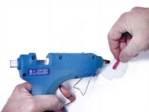 the nozzle at the gun's tip. Hot glue guns (also called hot-melt
glue guns) are used to bond a broad range of materials.
Most hardware stores and many department stores carry hot glue
guns and glue sticks. Many brands are sold, varying in quality
and price. Some accept nozzles
having openings producing extrusions
of different sizes and shapes. Most are electrical, some
use batteries, and some burn butane gas. The sticks can vary in
width and length
(from 4-12 inches), color, translucence,
and viscosity, as well as in
the temperature required to
melt the glue. Although lower melting
point guns and glues are safer to use, the strongest glues
are those with higher melting-points, and set
rapidly, bonding in 30 to 60 seconds.
the nozzle at the gun's tip. Hot glue guns (also called hot-melt
glue guns) are used to bond a broad range of materials.
Most hardware stores and many department stores carry hot glue
guns and glue sticks. Many brands are sold, varying in quality
and price. Some accept nozzles
having openings producing extrusions
of different sizes and shapes. Most are electrical, some
use batteries, and some burn butane gas. The sticks can vary in
width and length
(from 4-12 inches), color, translucence,
and viscosity, as well as in
the temperature required to
melt the glue. Although lower melting
point guns and glues are safer to use, the strongest glues
are those with higher melting-points, and set
rapidly, bonding in 30 to 60 seconds.
![]() Hot glue guns are reasonably safe to use.
However, the gun nozzle and the glue itself become very hot. Hot
enough to burn even careful users. As unpleasant and common as
this experience is, this kind of adhesive is very popular for
good reasons. People who like hot glue guns tolerate occasional
accidents, and learn to have fewer and lesser ones.
Hot glue guns are reasonably safe to use.
However, the gun nozzle and the glue itself become very hot. Hot
enough to burn even careful users. As unpleasant and common as
this experience is, this kind of adhesive is very popular for
good reasons. People who like hot glue guns tolerate occasional
accidents, and learn to have fewer and lesser ones. Users should plan ahead for the moment
they have a burn, by working near a source of
cold water — from a sink or a bucket. Quickly immersing
the affected skin in cool water can minimize both pain and damage.
One experience with a hot glue burn should be enough to convince
any skeptic of the wisdom of this advice. Another way to prevent
burns is to wear cloth gloves when using a
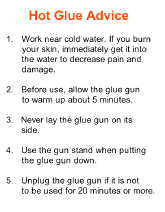 glue
gun. In the area where you and others will be using a hot glue
gun, display a printed copy of an enlarged version of the notice seen here.
glue
gun. In the area where you and others will be using a hot glue
gun, display a printed copy of an enlarged version of the notice seen here.
The heating element in a hot glue gun wears out over time. Fortunately many guns are inexpensive. This and their convenience recommends them for many applications. They are frequently used in manufacturing, packaging, stage-set, and other common crafting applications. Hot glue may be a good choice for many well-supervised school and college work, but it is less likely to be appropriate for many fine art applications, unless its relative crudeness is not objectionable. Hiding the look of hot glue in a piece of work can be difficult. If this is a problem, either use it with tremendous care or use a different adhesive or another joining method.
Related links:
Also see hazardous.
hot wire cutter - A tool for cutting Styrofoam. A wire is held taut in a frame and heated, enabling it to pass cleanly through the Styrofoam without undue pressure being applied. A hand-held or bench model may be used.
hue - The name of any color as found in its pure state in the spectrum or rainbow, or that aspect of any color. May refer to a particular wavelength. Pigment colors combine differently than colors of light. The primary colors (in pigment: red, yellow, and blue; in light: red, green, and blue) together with the secondary colors (in pigment: orange, green, and violet; in light: cyan, magenta, and yellow) form the chief colors of the spectrum.
Also see brilliant, color wheel, complementary colors, cool colors, dark, deep, monochrome, pale, push and pull, saturation, tint, tone, value, and warm colors.
humanism - Any attitude that gives priority to human endeavors, their values, capacities, worth, interests, needs, and welfare, rather than to those of the gods, the spirits, the animals, or any other non-human thing. Also, the study of the humanities. The term is frequently qualified, as in "Renaissance humanism," which is characterized by a love of the achievements of the Greco-Roman world, an optimism that humans are inherently endowed with the skills necessary to reshape the world according to their own needs, and a belief in inherent human dignity. While the Renaissance humanists did not see their enlightened self-interest as a contradiction of their Christianity, a few recent demagogues identify "secular humanism" as a tacitly atheistic preoccupation with human affairs.
Artworks resulting from the humanism which arose during the Renaissance:
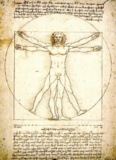
Leonardo da Vinci (Italian, 1452-1519), Study of proportions, from Vitruvius's
De Architectura, pen
and ink, 13 1/2 x 9 5/8 inches
(34.3 x 24.5 cm), Accademia, Venice. Leonardo, inspired
by the mathematician Vitruvius (Roman, 1st century BCE),
drew this famous picture of Vitruvian Man — a sort of ideal
figure — whose arm
span is equal to his height
— a ratio of one, or 1:1.
See a page with a math lesson plan for grades 6-8,
as well as articles on drawing,
proportion, and Renaissance.

Pieter Bruegel the Elder (Netherlandish,
active by 1551, died 1569), The Harvesters, 1565, oil
on wood panel;
overall, including added strips at top, bottom, and right, 46
7/8 x 63 3/4 inches (119 x 162 cm); original painted surface
45 7/8 x 62 7/8 inches (116.5 x 159.5 cm), Metropolitan Museum
of Art, NY. (On the Met's page, you can enlarge any detail.)
Also see ergonomics, isms and -ism, and multiculturalism.
humanities - The liberal arts — the non-scientific branches of study, such as philosophy, history, literature, and the arts, that are concerned with human thought and culture. On the other hand, Wilhelm Dilthey (1833-1911, German historian, psychologist, sociologist, philosopher, and student of hermeneutics) called the humanities (particularly history, law, literary criticism) the "spiritual sciences," as distinct from the the "natural sciences" (e.g. physics, chemistry, biology).
Other resources concerned with the humanities:
Also see humanism, the National Endowment for the Arts (NEA), and the National Endowment for the Humanities (NEH).
human scale - The size or proportion (scale) of a space, a part of a building, an article of furniture, or any other object, relative to the structural or functional dimensions of the human body.
Also see anatomy, architecture, design, ergonomics, figure, full-scale, lifesize, and visual scale.
hump mold - A type of drape mold, which see.
Hungarian art -
Making generalizations about the
visual culture of any group
of ![]() people
is a crude endeavor, especially with a culture as diverse as Hungary's.
With this thought in mind, know that this survey, as any must
be, is tremendously limited in its breadth and depth.
people
is a crude endeavor, especially with a culture as diverse as Hungary's.
With this thought in mind, know that this survey, as any must
be, is tremendously limited in its breadth and depth.
[Expect a more in-depth article to appear here soon.]
Examples:
Vilmos Zsolnay (Hungarian, 1828-1900), Vase, 1899, earthenware with iridescent metallic luster glaze, Minneapolis Institute of Arts. See Art Nouveau.

Mihály de Munkácsy (Hungarian,
1844-1900), The Music Room, 1878, oil
on canvas, 35 x 46 inches
(88.9 x 116.8 cm), Metropolitan Museum of Art, NY.

Alexander (Sándor) Bortnyik (Hungarian, 1893-1976), Geometric Forms in Space, 1923, oil on canvas, 18 1/4 x 23 5/8 inches (46.4 x 60 cm), Museum of Modern Art, NY. See geometric.
László Moholy-Nagy (German, born Hungary, 1895-1946, active in the US), Untitled (Positive), c. 1922-1924, gelatin silver print from photogram negative, .237 x .178 m (9 5/16 x 7 inches), National Gallery of Art, Washington D.C. See Bauhaus and German art.

Eva Zeisel (American, born Hungary, 1906-),
designer; Schramberg Majolica Factory (Schramberg, Germany),
manufacturer, Inkwell, 1929-30, glazed
earthenware, 3 3/8 x 9 x 9 3/8 inches (8.6 x 22.9 x 23.8 cm),
Metropolitan Museum of Art, NY.
André Kertész (Hungarian, 1894-1985), photographer. See photography.
Other resources:
Also see flags of Europe.
hurrygraph - The Oxford English Dictionary says a hurrygraph is a "jocular nonce-word" meaning hurried sketch.
hydria - An ancient Etruscan or Greek water jar or jug. Typically ceramic, with rounded shoulders, with two horizontally attached handles, and a vertical handle at the neck to assist in pouring. (pr. high'dree-uh) Among the other types of Greek vases are the alabastron, amphora, kantharos, krater, kylix, kyathos, lekythos, oinochoe, pelike, phiale, pinax, pithos, pyxis, and rhyton.
Examples:
Greece, Attic, Black-Figure Hydria with Scenes of Herakles, painted in the manner of the Antimenes Painter, late Archaic Period, c. 520-510 BCE, terra cotta, 20 1/8 x 13 3/8 inches (51.2 x 33.2cm), Michael C. Carlos Museum, Emory U, Atlanta, GA. See black-figure and Greek art.

Greece, Argive, Hydria with protome of a woman, c. 460
BCE,
Classical, bronze, height
with handle 20 1/4 inches (51.41 cm), Metropolitan Museum of
Art, NY.
hydrogen - A colorless, odorless, tasteless, slightly water-soluble, highly flammable
gaseous element, the lightest of all gases and the most abundant
element in the universe. The hot flame produced by a mixture of oxygen
and hydrogen is used in welding,
and in melting quartz and glass. Such
a flame is also called an oxyhydrogen torch. Tritium, one of hydrogen's
three isotopes, is used in luminous
paint. Tank size available: 191 cubic feet. Atomic symbol
H, atomic number 1.
Also see acetylene, argon, carbon dioxide, helium, and nitrogen.
hygroscopic - Having the capability of absorbing moisture. Examples of hygroscopic materials include textiles, woods, and papers.
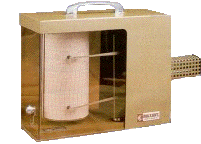
hygrothermograph - An instrument that measures and records temperature and relative humidity.
An example manufactured
by Preservation
Equipment Ltd.
Also see art conservation, cleavage, climate control, and technology.
hyperactive - Excess of energy, restless, easily distracted, unable to sit still.
hyperbola - A plane curve having two branches, formed by the intersection of a plane with both halves of a right circular cone at an angle parallel to the axis of the cone. It is the locus of points for which the difference of the distances from two given points is a constant. (hi:-purr'bə-lə) The plural form can be either hyperbolas or hyperbolae.
Related links:
Also see arc, cone, cylinder, ellipse, hyperbole, parabola, and sphere.
hyperbole - Exaggeration used for emphasis or effect. Some Baroque ceiling paintings are extravagantly hyperbolic.
(pr. hi-PURR-bə-lee)
Also see hyperbola.
hyperlink - See hypermedia.
hypermedia - A type of computer imagery which employs a programming technique allowing users to switch between a variety of other screen images, each of which might be derived from information stored either on the same or on networked computers. The World Wide Web (WWW) is an important example of hypermedia. Another is a program called Hyperstudio. Any place on a computer screen image which serves to facilitate switching to another screen image is called a hyperlink, or a link.
Related resource:
Lasting Image is an online short story with copious hyperlinks.
Also see new media.
Hypertext Markup Language (HTML) - An encoding format for identifying and linking electronic documents used to deliver information on the Internet's World Wide Web (WWW).
Also see new media.
hypoactive - Absence of energy, lethargic, listless, very quiet.
hypostyle hall - In architecture, a hall with a roof supported by columns; applied to the colonnaded hall of the Egyptian pylon temple.
Examples:

Egypt, The
Hypostyle Hall of the Great Temple of Ammon at Karnak,
c. 1312-1301 BCE,
338 x 170 feet, 134 columns in 16 rows, the central avenues are
about 78 feet in height, and
have columns 69 feet high and 11 feet 9 inches in diameter,
with capitals of the papyrus-flower or bell type,
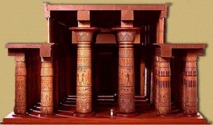 while
in order to admit light through the clerestory,
the side avenues are lower with columns 42 1/2 feet high and
8 feet 9 inches in diameter. The Metropolitan Museum, NY, displays
while
in order to admit light through the clerestory,
the side avenues are lower with columns 42 1/2 feet high and
8 feet 9 inches in diameter. The Metropolitan Museum, NY, displays
a model of this hypostyle hall as it originally
appeared. See Egyptian
art and papyrus.
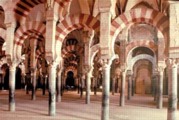
Hypostyle Hall of the Great Mosque of Córdoba,
Spain, begun 786, doubled in area in the 10th century to 585
x 410 feet, with 1,200 columns
supporting horseshoe arches,
patterned with
colored marbles and other stones.
 Although it was converted
into Córdoba's Roman Catholic cathedral
in 1238, the building is known locally as La Mezquita
— The Mosque.
Although it was converted
into Córdoba's Roman Catholic cathedral
in 1238, the building is known locally as La Mezquita
— The Mosque. See an aerial view of La
Mezquita, showing the Christian
alterations. See aerial view
and Islamic art.
https://inform.quest/_art